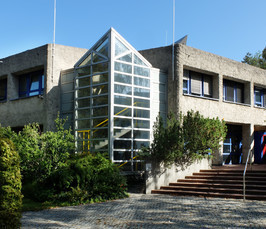Reaching for the stars with density functional theory
- Online Seminar of the NOMAD Laboratory
- Date: Feb 11, 2021
- Time: 11:15 AM (Local Time Germany)
- Speaker: Mandy Bethkenhagen
- École Normale Supérieure de Lyon
- Location: https://us02web.zoom.us/j/83988064771?pwd=MUVvaFoxNUwzcEE1UmxFWU5xWGdvUT09
- Room: Meeting ID: 839 8806 4771 I Passcode: NOMAD
- Host: NOMAD Laboratory

However, while the equations of states and transport properties for giant
planets like Jupiter or Neptune became increasingly accessible with DFT-MD simulations in the last
two decades, extreme conditions as predicted for the interiors of brown dwarfs and low-mass stars
seemed beyond reach.
For very high densities, traditional DFT-MD calculations are still feasible at millions of Kelvin as this
talk will discuss for several applications including the equation of state, transport and material
properties of hydrogen-helium, beryllium and carbon [1,2]. Additionally, a new ab initio approach
to calculate the ionization degree based on the sum rule for the dynamic electrical conductivity is
demonstrated [2]. We find a significantly higher carbon ionization degree than predicted by
commonly used models, yet validating the qualitative behavior predicted by average atom models.
The results are directly used to model the plasma parameters of ongoing experimental campaigns
at the National Ignition Facility aiming at recreating the conditions inside brown dwarfs and lowmass
stars.
At low densities and high temperatures, however, traditional plane-wave codes become
intractable, because the number of partially occupied states increases significantly. This problem is
addressed with the novel SQDFT code, which is a large-scale implementation of the Spectral
Quadrature (SQ) method for O(N) Kohn-Sham DFT calculations [3,4]. The new capabilities of SQDFT
are demonstrated for the Hugoniot curve for carbon up to 10 million Kelvin.
[1] A. Becker, M. Bethkenhagen, C. Kellermann, J. Wicht, R. Redmer, Astronomical Journal 156, 149
(2018).
[2] M. Bethkenhagen, B.B.L. Witte, M. Schörner, G. Röpke, T. Döppner, D. Kraus, S. H. Glenzer, P. A.
Sterne, R. Redmer, Physical Review Research 2, 023260 (2020).
[3] P. Suryanarayana, P. P. Pratapa, A. Sharma, and J. E. Pask, Computer Physics Communications
224, 288 (2018).
[4] A. Sharma, S. Hamel, M. Bethkenhagen, J. E. Pask, P. Suryanarayana, Journal of Chemical Physics
153, 034112 (2020).